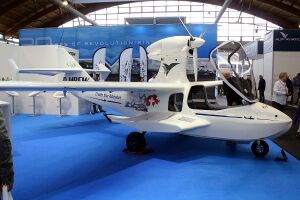Engineering:Flywhale Aircraft Flywhale
| Flywhale | |
|---|---|

| |
| Role | Sports amphibian |
| National origin | Germany |
| Manufacturer | Uniplanes GmbH |
| First flight | 13 September 2013 |
| Number built | 10 (2020) |
The Flywhale FW650 was a two-seat amphibious sports aircraft designed and built in Germany by Uniplanes GmbH. It is now owned and built by Dornier Seawings under the name DS-2C.
Design and development
The Flywhale, built mainly from carbon fibre composite materials, is a flying boat style amphibian, with a single step hull and sponsons rather than wing tip floats. It accommodates two in side-by-side seating fitted with a single control between both seats. The design also provides room for two people to sleep in the fuselage.[1][2] A large, one-piece canopy hinges forward for access.[3] Behind the seats is a baggage area. The Flywhale has short-legged, tricycle landing gear[1] with mainwheels retracting backwards into the sponsons.[3] It can operate on land and water.[2]
Its high cantilever wings are trapezoidal in plan and can be removed for transport. Its empennage is cruciform, with the horizontal tail part-way up a triangular fin and rudder. A 75 kW (100 hp) Rotax 912 iS flat-four engine is mounted on a necked pylon over the wing in tractor configuration.[1] This originally drove a two blade propeller[1] but more recently a three-bladed one has replaced it.[3] A BRS ballistic parachute is an option.[1]
The Flywhale flew for the first time on 13 September 2013.[1] A second airframe has been completed, including modifications suggested by the flight trials of the first,[1] and this flew in the summer of 2015.[3]
On 19 January 2022, Dornier Seawings announced that they had acquired all intellectual property and production assets of the Flywhale project, which would henceforth by known as the Dornier Seawings DS-2C, alongside the larger Dornier Seastar.[4]
Variants
- Adventure
- Standard version as in Specifications
Specifications (Adventure)
Data from Jane's All the World's Aircraft 2015-16[1]
General characteristics
- Crew: One pilot
- Capacity: One passenger
- Length: 6.45 m (21 ft 2 in)
- Wingspan: 9.00 m (29 ft 6 in)
- Height: 2.35 m (7 ft 9 in)
- Empty weight: 345–400 kg (761–882 lb)
- Max takeoff weight: 650 kg (1,433 lb) with rescue parachute
- Fuel capacity: 106 L (23 imp gal; 28 US gal)
- Powerplant: 1 × Rotax 912 iS flat-four, 75 kW (101 hp)
- Propellers: 3-bladed , constant speed
Performance
- Cruise speed: 200 km/h (120 mph, 110 kn)
- Stall speed: 72 km/h (45 mph, 39 kn)
- Never exceed speed: 250 km/h (160 mph, 130 kn)
- Endurance: 6 hr 0 min
- g limits: +4/-2
References
- ↑ 1.0 1.1 1.2 1.3 1.4 1.5 1.6 1.7 Gunston, Bill (2015). Jane's All the World's Aircraft : development & production : 2015-16. IHS Global. pp. 265. ISBN 978-0-7106-3135-0.
- ↑ 2.0 2.1 Tacke, Willi; Marino Boric; et al: World Directory of Light Aviation 2015-16, page 56. Flying Pages Europe SARL, 2015. ISSN 1368-485X
- ↑ 3.0 3.1 3.2 3.3 "Flywhale Aircraft". http://flywhale.de/en/flywhale.html. Retrieved 6 November 2015.
- ↑ "Dornier Seawings acquires Flywhale project from Uniplanes GmbH". 19 January 2022. https://dornierseawings.com/dornier-seawings-acquires-flywhale-project-from-uniplanes-gmbh/. Retrieved 21 January 2022.
External links
 |

